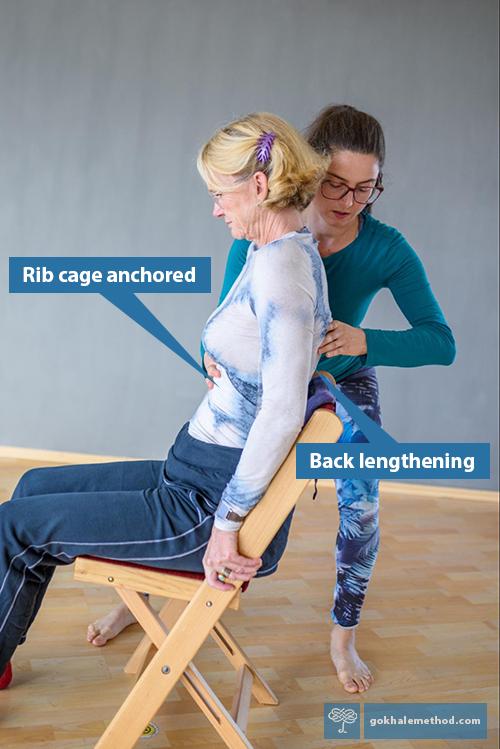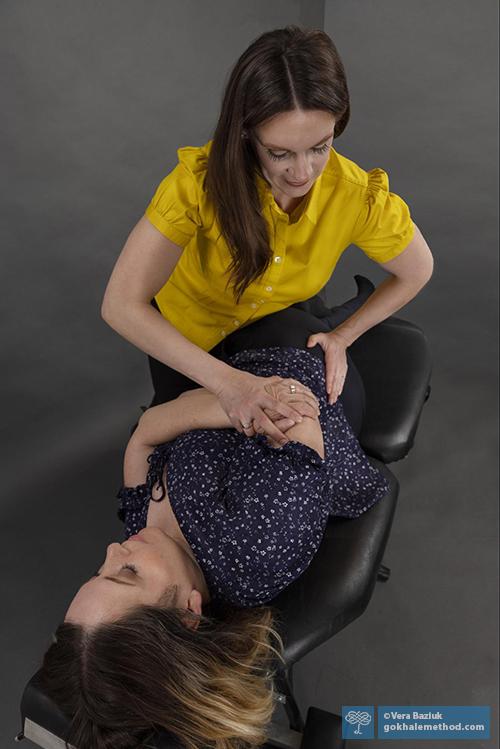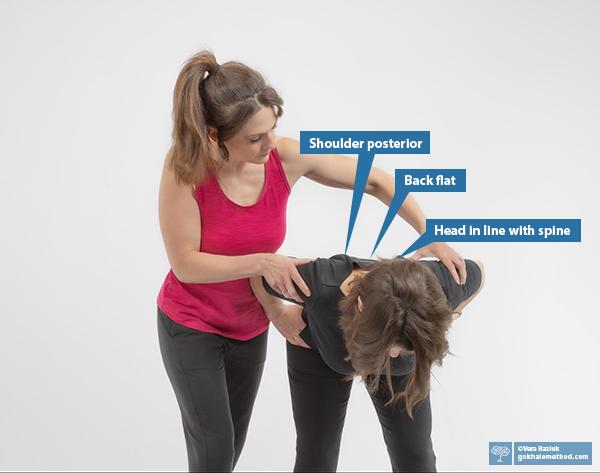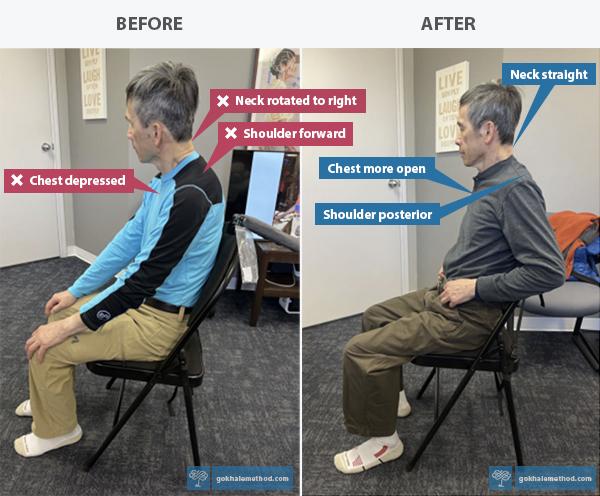The Gokhale Method and Chiropractic
If you have had back pain, odds are that you have visited either a physical therapist or a chiropractor. They are the most frequented medical practitioners for all types of structural pain, and our teacher community has been enriched by both these (and many other types of) practitioners. For this post, I have invited Vera Baziuk, a chiropractor and Gokhale Method® teacher based in Edmonton, Canada, to join me for a Q&A. We would like to share with you how she sees the interface between chiropractic and our method.

Gokhale Method teacher and chiropractor Vera Baziuk.
E: How did you first discover the Gokhale Method?
V: I was researching the best home exercises and stretches for certain patients for back pain relief. I felt that this was a missing component in chiropractic for fully resolving back pain. I stumbled upon an interview with you and Dr. Mercola. What you said in the beginning about the J-spine grabbed my attention. I immediately went to the Gokhale Method website and downloaded your book, 8 Steps to a Pain-Free Back
This was one of those career aha moments, when I know on an inner, deeper level, that something is right and what I need to be doing. I began looking into teacher training in November 2019, however, teacher training was not going to be possible with a three-month-old, and I still needed to take the Foundations course. Then COVID hit.
I took the online Elements course in the spring/summer of 2020, right in the middle of COVID, and waited for the announcement of teacher training. In fall of 2021, I gained in-person experience in a Pop-up class in Palo Alto. That weekend was amazing! I had never felt quite the stretch before as when Esther adjusted my stretchsitting. I shall never forget that initial amazing feeling of lengthening in my erector spinae muscles and ultimately the spine. I wanted everyone I knew to feel how good that felt. If I wasn’t hooked before, I was after that class!

Gokhale Method teacher Sabina Blumauer guides a student in stretchsitting.
E: Were you initially skeptical about the Gokhale Method?
V: No, I wasn’t. The interview I heard between you and Dr. Mercola made complete sense. The book and Elements made a well-presented argument for the natural J-shape of the spine, supported by analysis of body mechanics, muscle contraction, and relaxation. Hundreds of photos showed how the spine looks when posture is done well in daily activities—and how things look when it is not. It became evident that poor posture was the real culprit to back pain. And that the posture pot of gold is still attainable at any age.
E: Do you see any divergence between chiropractic and the Gokhale Method?
V: The main thing I encounter, from fellow health professionals and patients, is confusion about healthy spine shape and pelvic position.
For example, in conventional trainings, having an anterior pelvic tilt is equated with having an excessive lumbar lordosis. The Gokhale Method makes the important distinction between upper lumbar lordosis (undesirable) and L5-S1 angle (desirable). The Gokhale Method also uses more descriptive and “sticky” language when it comes to spinal shape—instead of talking about lordosis and kyphosis, we refer to J-spines, C-spines, and S-spines; this helps students understand what they need to embody more accurately and easily. This is explained and illustrated in detail in your book, and also addressed in a blog post on spine shape and another on pelvic angle.
E: Has the Gokhale Method complimented your practice as a chiropractor?
V: Incorporating the Gokhale Method into my practice is a natural fit because, ideally, there is an active and passive component to most healing.
Passive care is when the chiropractor (or therapist) does something to you, like an adjustment, mobilization, TENS, ultrasound, laser, soft tissue therapy, or acupuncture. While these modalities can be effective in providing relief from pain, they often do not solve the root cause of the problem. Unfortunately, perhaps due to persuasive marketing, people often expect entirely passive solutions for their back pain. They begin to believe that a magic bullet for back pain relief exists.

Here I am giving a patient a chiropractic adjustment. This is an example of passive care, using diagnostic skills and clinical knowledge, plus hands on techniques, to effect change.
Active care consists of therapists providing tools to their patients/clients that they can use in their day-to-day lives to help them in recovery. These may be cryotherapy or heat, exercises to strengthen muscles and stretches to lengthen muscles, nutritional advice to improve healing, stress management tips, and general physical fitness recommendations. This active care component is critical in creating lasting, functional changes.
The Gokhale Method provides high quality active care. It is an educational intervention that teaches and empowers people to make gentle changes to their body 24/7, often with both immediate and cumulative benefits. I don’t know of any other intervention that does this so comprehensively and also includes the J-spine paradigm.
E: So you see the Gokhale Method and chiropractic as working together?
V: Yes, absolutely. The Gokhale Method helps chiropractic adjustments hold more effectively and chiropractic adjustments give people a welcome jumpstart on feeling better.
Most people who come for chiropractic treatment have sustained a lot of damage over the years in their muscles, tendons, ligaments, discs, and joints, so experiencing a break from their cycle of pain is very welcome. But partial or repeated short-term relief from pain is ultimately unsatisfying, both for the patient and practitioner. The Gokhale Method offers ways of transforming the postural habits that caused the problem in the first place. I find that, given most people’s starting point, a combination approach restores function, gives long term relief, and improves comfort along the way.

My Gokhale Method students find learning how to rest and sleep in comfortable, therapeutic positions makes an invaluable contribution to their recovery. Here I am teaching stretchlying.
E: What impact has the Gokhale Method had on your thinking about chiropractic?
V: I feel like my eyes have finally opened. For example, revisiting my textbooks, I noticed that references to posture are minimal and often an afterthought. Dr. David Magee is a well-respected physiotherapist who has written numerous classic orthopedic and physical examination books that both chiropractors and physiotherapists still learn from today. I began to wonder why, in one of his books, Posture Assessment is Chapter 15 of 17? It should be Chapter 1! Nearly all musculoskeletal conditions are a direct result of poor posture.
E: Do you discuss the subject of posture with your patients?
V: I now see my patients’ complaints through the Gokhale lens, with posture as the starting point. Looking at someone in the past, I could see their posture was not ideal, but I still dealt with their presenting complaint in parts, not as a whole. For the past year, I have switched my filter and now consider all musculoskeletal pain in relation to posture.
When speaking to patients for the first time, I begin to paint the picture of what healthy posture looks like and how their current posture compares. We then explore options to solve the problem with some immediate pain relief solutions and a longer-term relief and prevention strategy—the Gokhale Method.

Teaching my Gokhale Method students healthy bending not only enables them to avoid future back pain flare-ups and protect against damage, it also brings many other biomechanical benefits—such as natural length in the hamstrings and improved hip joint mobility.
For existing patients, I periodically offer observations on how their current posture is very likely contributing to a flare up or increase of pain from their last appointment. Many wholeheartedly welcome hearing more about the Gokhale Method.
E: Can you share a specific case where the Gokhale Method has enhanced the outcome for a patient?
V: In September of 2023, I met Kay Chui Lee, who is happy to share his journey. He was referred by a massage therapist, and presented wearing a cervical collar for an acquired torticollis (neck twist to one side). His posture was a significant C-shaped spine, with a very tucked pelvis and his hips parked forward. His erector spinae were perhaps the tightest I have ever felt. In addition, he had tight sternocleidomastoid, scalene, levator scapulae, and trapezius muscles. His gluteal muscular tone was weak.
Kay Lee started as a chiropractic patient, and, to best serve his needs, I also encouraged him to enroll in the Gokhale Foundations course. He stopped wearing his cervical collar about halfway through the course. After the course, his neck and head rotation to the right had improved and there were times when Kay was able to look straight ahead.

A combination of the Gokhale Method and chiropractic treatment is enabling Kay Lee to gradually become more upright. His head and neck are returning to a more natural, comfortable, and symmetric alignment.
He walks daily, practicing what he learnt in glidewalking, and reports doing so without the fatigue he used to feel after a walk. He sleeps better and can manage his day with greater comfort. The texture in his erector spinae muscles is softening and he reports less pain with muscle work. To date, Kay continues with chiropractic treatment and there are ongoing improvements. I am hopeful that with alumni classes, online or in-person, he will continue to improve.
E: Thanks, Vera, for sharing how you are using chiropractic alongside the Gokhale Method. I am sure your insights will help both our students, and chiropractors and their patients, to embrace this complementary pairing with a new level of confidence.
Best next action steps
If you would like to improve your posture, get started by booking a consultation, online or in person, with one of our teachers.
You can sign up below to join any one of our upcoming FREE Online Workshops…

Comments
Super article! Thanks Esther
Super article! Thanks Esther and thanks Vera!
I couldn't agree more with
I couldn't agree more with your views on using a chiropractor to complement the Gokhale Method. Most especially, your emphasis on the fact that it needs to be a collaborative effort between the chiropractor and the patient – each has their own responsibility. I go to my chiropractor as a student so I can further my healing process
The instant I heard Esther on NPR I knew that the implications up the line that would occur if I were to beanshape properly was just what I needed to go about relaxing my muscles and tendons to rearrange my frame.
I had spent four years in the 90s using a bodybuilder's approach to fix my injured shoulders and back. I was successful in keeping pain at bay but at the expense of mobility.
This time around doing exactly the same thing with the Gokhale filter has given me the mobility I haven't had for decades. It's the perfect template from which to plan your approach.
About six months ago, my chiropractor mobilized T1C7 and – in Gokhale terms – such a pivotal juncture for looking up-that from that moment, everything finally started to slowly loosen.
I work with my GM teacher, who also happens to be an acupuncturist and energy worker – my two favorite modalities – and using the logic of the Gokhale Method and bodybuilding from the inside out, you can't lose.
At my last visit, my chiropractor was quite surprised since he was able to adjust 7 vertebrae and both SI joints. He said, "I don't know what you're doing, but keep doing it." I will definitely send this article along to him.
Fabulous article, thanks!
Add New Comment
Login to add commment
Login